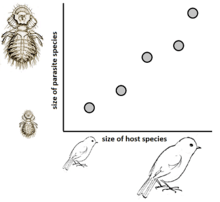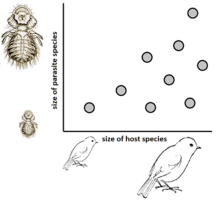Harrison's rule



Harrison’s rule is an observation in evolutionary biology by Launcelot Harrison which states that in comparisons across closely related species, host and parasite body sizes tend to covary positively.
Parasite species’ body size increases with host species’ body size
Launcelot Harrison, an Australian authority in zoology and parasitology, published a study in 1915 concluding that host and parasite body sizes tend to covary positively,[1] a covariation later dubbed as 'Harrison’s rule'. Harrison himself originally proposed it to interpret the variability of congeneric louse species. However, subsequent authors verified it for a wide variety of parasitic organisms including nematodes,[2][3][4][5] rhizocephalan barnacles,[6] fleas, lice, ticks, parasitic flies and mites, as well as herbivorous insects associated with specific host plants.[3][7][8]
The variability of parasite species’ body size increases with host species’ body size
Robert Poulin observed that in comparisons across species, the variability of parasite body size also increases with host body size.[9] It is self-evident that we expect greater variation coming together with greater mean body sizes due to an allometric power law scaling effect.[10] However, Poulin referred to parasites’ increasing body size variability due to biological reasons, thus we expect an increase greater than that caused by a scaling effect.
Recently, Harnos et al. applied phylogenetically controlled statistical methods to test Harrison’s rule and Poulin’s s Increasing Variance Hypothesis in avian lice.[11] Their results indicate that the three major families of avian lice (Ricinidae, Menoponidae, Philopteridae) follow Harrison’s rule, and two of them (Menoponidae, Philopteridae) also follow Poulin’s supplement to it.
Implications
The allometry between host and parasite body sizes constitutes an evident aspect of host–parasite coevolution. The slope of this relationship is a taxon-specific character. Parasites' body size is known to covary positively with fecundity[12] and thus it likely affects the virulence of parasitic infections as well.
References
- ↑ Harrison, Launcelot (1915). "Mallophaga from Apteryx, and their significance; with a note on the genus Rallicola" (PDF). Parasitology. 8: 88–100.
- ↑ Kirchner, TB; Anderson, RV; Ingham, RE (1980). "Natural selection and the distribution of nematode sizes". Ecology. 61: 232–237.
- 1 2 Harvey, PH; Keymer, AE (1991). "Comparing life histories using phylogenies". Philosophical Transactions of the Royal Society B. 332: 31–39.
- ↑ Morand, S; Legendre, P; Gardner, SL; Hugot, JP (1996). "Body size evolution of oxyurid (Nematoda) parasites: the role of hosts". Oecologia. 107: 274–282.
- ↑ Morand, S; Sorci, G (1998). "Determinants of life-history evolution in nematodes" (PDF). Parasitology Today. 14: 193–196.
- ↑ Poulin, R; Hamilton, WJ (1997). "Ecological correlates of body size and egg size in parasitic Ascothoracida and Rhizocephala (Crustacea)" (PDF). Acta Oecologica. 18: 621–635.
- ↑ Morand, S; Hafner, MS; Page, RDM; Reed, DL (2000). "Comparative body size relationships in pocket gophers and their chewing lice" (PDF). Zoological Journal of the Linnean Society. 70: 239–249.
- ↑ Johnson, KP; Bush, SE; Clayton, DH (2005). "Correlated evolution of host and parasite body size: tests of Harrison's rule using birds and lice" (PDF). Evolution. 59: 1744–1753.
- ↑ Poulin, R (2006). Evolutionary ecology of parasites. Princeton University Press. ISBN 9780691120850.
- ↑ Xiao, X; White, EP; Hooten, MB; Durham, SL (2011). "On the use of log-transformation vs. nonlinear regression for analyzing biological power-laws". Ecology. 92: 1887–1894.
- ↑ Harnos, A; Lang, Z; Petras, D; Bush, SE; Szabo, K; Rozsa, L (2017). "Size matters for lice on birds: coevolutionary allometry of host and parasite body size" (PDF). Evolution. 92: 1887–1894.
- ↑ Villa, SM; Evans, MD; Subhani, YK; Altuna, JC; Bush, SE; Clayton, DH (2018). "Body size and fecundity are correlated in feather lice (Phthiraptera: Ischnocera): implications for Harrison's rule". Ecological Entomology (in press).